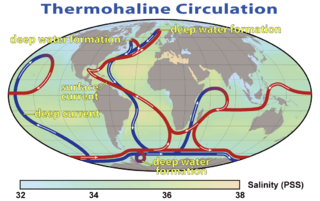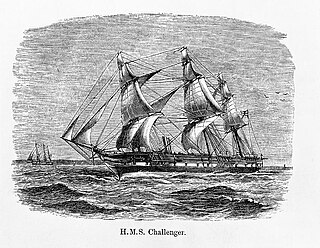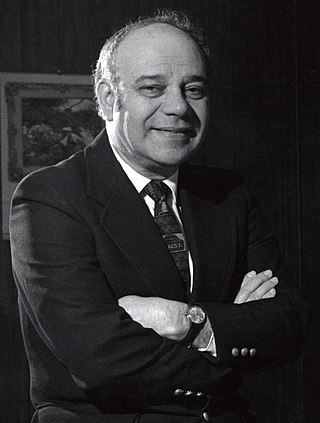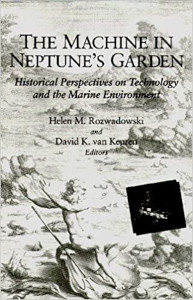
Oceanography, also known as oceanology, sea science,ocean science, and marine science, is the scientific study of the oceans. It is an Earth science, which covers a wide range of topics, including ecosystem dynamics; ocean currents, waves, and geophysical fluid dynamics; plate tectonics and seabed geology; and fluxes of various chemical substances and physical properties within the ocean and across its boundaries. These diverse topics reflect multiple disciplines that oceanographers utilize to glean further knowledge of the world ocean, including astronomy, biology, chemistry, geography, geology, hydrology, meteorology and physics. Paleoceanography studies the history of the oceans in the geologic past. An oceanographer is a person who studies many matters concerned with oceans, including marine geology, physics, chemistry, and biology.

The Challenger expedition of 1872–1876 was a scientific programme that made many discoveries to lay the foundation of oceanography. The expedition was named after the naval vessel that undertook the trip, HMS Challenger.
The American Miscellaneous Society was an informal group made up of the more eccentric members of the US scientific community. It was formed by Gordon Lill, of the Office of Naval Research, as an organization designed to collect various Earth science research ideas that were submitted by scientists to the U.S. Navy and did not fit into any particular category. Membership in AMSOC was open to everyone and so there was no official membership list. Prospective members could join whenever two or more members were together. The most famous project to come out of AMSOC was the Project Mohole, whose goal was to drill into the Earth's mantle. Hollis Hedberg of Gulf Oil Corporation chaired the AMSOC Mohole subcommittee from 1962 to 1963. The society dissolved itself in 1964.

Jerome Karle was an American physical chemist. Jointly with Herbert A. Hauptman, he was awarded the Nobel Prize in Chemistry in 1985, for the direct analysis of crystal structures using X-ray scattering techniques.
Edwin Henry Colpitts was a communications pioneer best known for his invention of the Colpitts oscillator. As research branch chief for Western Electric in the early 1900s, he and scientists under his direction achieved significant advances in the development of oscillators and vacuum tube push–pull amplifiers. In 1915, his team successfully demonstrated the first transatlantic radio telephone. Colpitts died at home in 1949 in Orange, New Jersey, United States and his body was interred in Point de Bute, New Brunswick, Canada. He was survived by his wife Grace Penney Colpitts and his son Donald B. Colpitts.

Milky seas, also called mareel, is a luminous phenomenon in the ocean in which large areas of seawater appear to glow translucently. Such occurrences glow brightly enough at night to be visible from satellites orbiting Earth.

Project Mohole was an attempt in the early 1960s to drill through the Earth's crust to obtain samples of the Mohorovičić discontinuity, or Moho, the boundary between the Earth's crust and mantle. The project was intended to provide an earth science complement to the high-profile Space Race. While such a project was not feasible on land, drilling in the open ocean was more feasible, because the mantle lies much closer to the sea floor.

The Station biologique de Roscoff (SBR) is a French marine biology and oceanography research and teaching center. Founded by Henri de Lacaze-Duthiers (1821–1901) in 1872, it is at the present time affiliated to the Sorbonne University (SU) and the Centre National de la Recherche Scientifique (CNRS).
Cindy Lee Van Dover is the Harvey Smith Professor of Biological Oceanography and chair of the Division of Marine Science and Conservation at Duke University. She is also the director of the Duke University Marine Laboratory. Her primary area of research is oceanography, but she also studies biodiversity, biogeochemistry, conservation biology, ecology, and marine science.

A cabled observatory is a seabed oceanographic research platform connected to land by cables that provide power and communication. Observatories are outfitted with a multitude of scientific instruments that can collect many kinds of data from the seafloor and water column. By removing the limitations of undersea power sources and sonar or RF communications, cabled observatories allow persistent study of underwater phenomena. Data from these instruments is relayed to a land station and data networks, such as Ocean Networks Canada, in real time.

Caribbean Research and Management of Biodiversity Foundation is a research organization in Curaçao, former Netherlands Antilles. It is situated in Piscadera Bay, 25 metres (82 ft) from the Caribbean Sea. Its education and research programs include the ecological aspects of fisheries and coral reef sciences.

Judith Munk was an American artist and designer associated with Scripps Institution of Oceanography. She was inducted into the San Diego Women's Hall of Fame posthumously, in 2008.

George G. Shor Jr. was an American marine geophysicist. His entire career was at the Scripps Institution of Oceanography in La Jolla, California. He began his career working with the Mohole Project, an ambitious project that attempted to drill to the Mohorovičić discontinuity from deep-ocean regions.

All the Fish in the Sea: Maximum Sustainable Yield and the Failure of Fisheries Management is a 2011 book by Carmel Finley. The book argues that the policies for international fishing and whaling management were essentially locked in place by 1958, and that the United States played a large role in setting them. In the development of the international law covering fisheries, the US supported laws that would protect the US tuna and salmon fisheries while limiting the ability of other nations, and Japan in particular, to fish in US waters. The book thus ties fisheries management inseparably with Cold War politics.
Emilie Savage-Smith is an American-British historian of science known for her work on science in the medieval Islamic world and medicine in the medieval Islamic world.

Particulate inorganic carbon (PIC) can be contrasted with dissolved inorganic carbon (DIC), the other form of inorganic carbon found in the ocean. These distinctions are important in chemical oceanography. Particulate inorganic carbon is sometimes called suspended inorganic carbon. In operational terms, it is defined as the inorganic carbon in particulate form that is too large to pass through the filter used to separate dissolved inorganic carbon.
Scott Doney is a marine scientist at the University of Virginia known for his work on biogeochemical modeling. Doney is the Joe D. and Helen J. Kington Professor in Environmental Change, a fellow of the American Geophysical Union, the American Association for the Advancement of Science., and the Association for the Sciences of Limnology and Oceanography. He served from 2022 to 2024 as the Assistant Director for Ocean Climate Science and Policy in the White House Office of Science and Technology Policy.
Elizabeth Kujawinski is an American oceanographer who is Senior Scientist at the Woods Hole Oceanographic Institution, where she works as Program Director of the Center for Chemical Currencies of a Microbial Planet. Her research considers analytical chemistry, chemical oceanography, microbiology and microbial ecology. She is interested in what controls the composition of organic materials in aquatic systems.
Carin Jessica Ashjian is an American biological oceanographer who is an associate scientist at the Woods Hole Oceanographic Institution. She studies how the physical environment influences the distribution of plankton in the Beaufort Sea.
Jacob Darwin Hamblin is an American professor of history, specializing in international aspects of science, technology, and the global environment. His 2013 book Arming Mother Nature: The Birth of Catastrophic Environmentalism won two prestigious awards: the 2014 Paul Birdsall Prize and the 2016 Watson Davis and Helen Miles Davis Prize.












